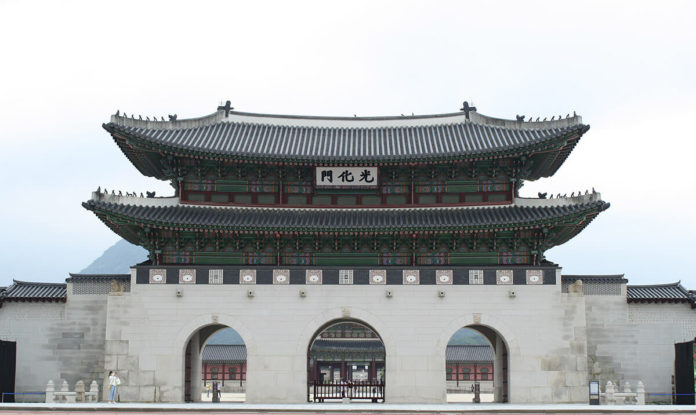Written by Tom McCarthy
As 1 o’clock approached, I left my apartment in Itaewon and headed to the bus stop, bound for the G.O.A.’L. office in Jongno. Before stepping out my front door, I ran though my usual checklist: keys, wallet, phone. There has been one new addition since February; mask. After the explosion of COVID-19 cases (still called “Coronavirus” in Korean) in February and March, masks have been more commonplace than ever.
Western news media have placed an emphasis on the prevalence of masks year-round in Asia, from flu season to pollen season and heavily-polluted days in between. Eight months later, precautionary measures are still in place, largely without the resistance found in other countries.
As I rode the bus toward the heart of Seoul (and the location of several outbreak clusters in the previous months), I watched riders carefully adjust their masks before boarding at each stop, ensuring that their face was fully covered. As passengers made their way onto the bus in front of Myeongdong, the driver suddenly barked at a middle-aged man attempting to board. “Put on a mask!” he said in Korean. The surprised passenger immediately pulled a mask from his pocket, apologizing half-heartedly to the driver and averting the stares of fellow passengers.
As I reached the G.O.A.’L. office, I passed throngs of office workers making their way back to their offices after lunch. Swarms of mask-wearing, hand-sanitizing professionals poured out of the restaurants around the We’ve Pavilion building, home to several businesses, embassies, and other NGOs. Enough has been written about the source of proactive measures in Korea when it comes to pandemics. Even still, seeing such universal compliance in action has been eye-opening.
As I entered the office building, I doused my hands in hand sanitizer, a new standard feature in all buildings, subways, and buses. I accessed the office’s floor by pushing an elevator button covered with an antibacterial film. After greeting the office, I immediately departed with Eirik, Dave, and Kara to explore downtown Seoul and document the new normal.
Our first stop was the grand central plaza, Gwanghwamun Square. On this tower-lined boulevard leading up to Gyeongbokgung, the fallout from the virus was immediately noticeable. Despite the nearly-unbearable tropical weather, June to August is statistically peak tourism season. Where once there were endless rows of tents offering various cultural wares and experiences, the square was nearly desolate, save for some persistent protesters who seem to be as permanent as the King Sejong and Yi Sun-shin statues at one end of the pavilion. A glance inside the palace at the end of the street revealed a significant absence of visitors, proving this, paradoxically, to be an ideal time for a quality photo shoot.

We turned east toward Insadong, the fabled tourist shopping street. Here, the virus appeared to be dealing devastating blows to the shopkeepers that line what was once one of the most expensive real estate areas in the city. This trend continued as we ventured south toward Myeongdong, the retail shopping hub of Seoul.
On a Friday evening any other year, this district would be suffocatingly dense with tourists from all over the world, drawn in by employees positioned outside their stores appealing to Asian passers-by in their presumptive native languages (a risky but surprisingly accurate gamble when it comes to Asian shoppers; non-Asians are uniformly greeted with English). On this day, however, the sales people could only be heard soliciting in Korean, such was the lack of tourists. We snapped some surreal photos of a relatively empty Myeongdong and moved on.
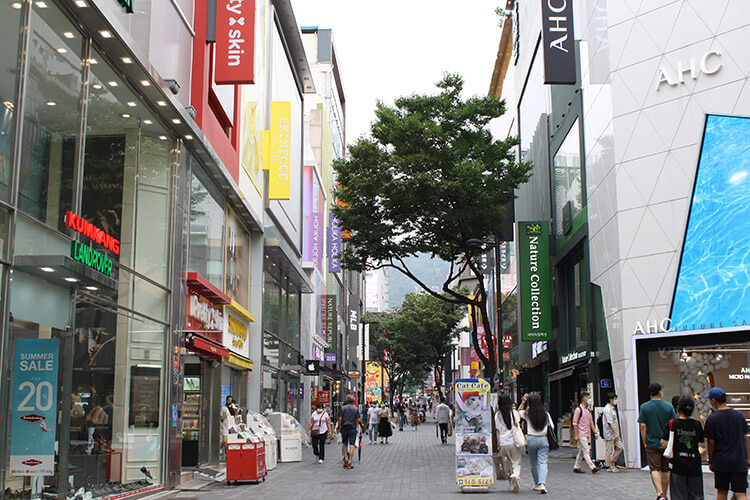
As with all stories, there are two sides of the coin. On the street and in tourist (or foreign) districts, the danger of the virus is typically of paramount concern. A lack of consumers is hurting business in major shopping areas frequented by non-Koreans. After an outbreak was traced back to Itaewon, the result of sheer misfortune really, the restaurants in the area had to demonstrate even more aggressive “social distancing” posturing, closing off half of the seats in their restaurants in a largely-inconsequential attempt to show Koreans that they shared the same level of concern for safety. However, a quick jaunt into a “Korean” district or neighborhood would prove that caution stops at the water’s edge, or rather, the door’s edge.
After Myeongdong, we took a stroll through Ikseondong, bustling with post-work activity. An Instagrammer’s dream neighborhood, it has been rising in popularity for its traditional Korean exteriors paired with modern, minimalist interior design. Here, cafes were packed to maximum capacity.
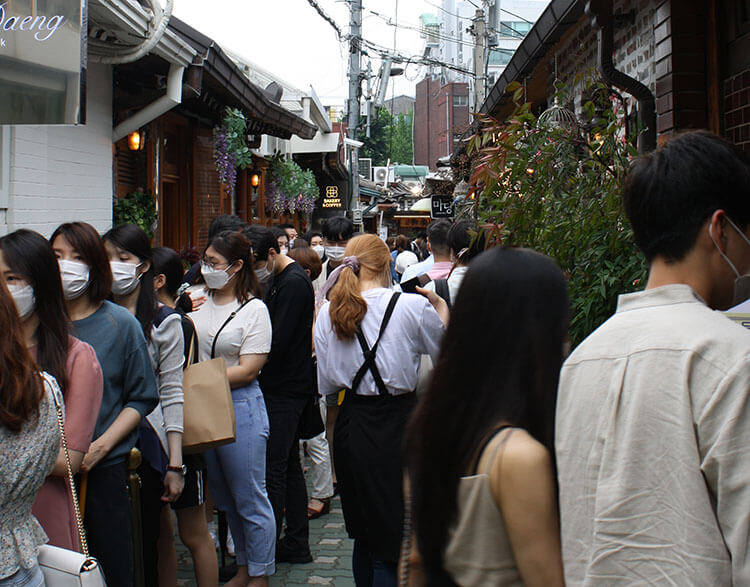
After witnessing how not-affected this charming district was, we decided it was time for dinner. At the southeast corner of this neighborhood is a famous Korean barbecue street, lined with restaurants offering dense indoor tables and breezy (but equally compact) outdoor seating. Once inside a barbecue restaurant, time appeared to have stopped and we were transported back to 2019, save for the employees. Places popular with Koreans like Ikseondong were continually packed. Like in other countries, many stores were killed off by the pandemic in masks. In “Korean” Korea, little precaution is taken compared to the diligence exercised when venturing into the likes of Itaewon or Myeongdong. We were packed into a set of grills so close to the neighboring tables I accidentally bumped into fellow diners while simply adjusting my posture. In this enclave of Korean salary men and trendy millennials, we nearly forgot we were in the midst of a pandemic, and clearly every other patron had, too.
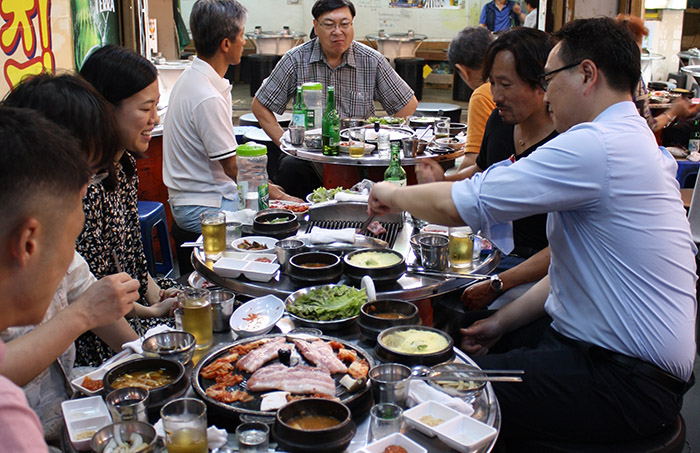
After dinner, we decided to see if this was a city-wide phenomenon and went for a second round near Jongno 3-ga, one of the few streets that still host pojangmacha, the street stalls that the government has sought to eradicate since 2012. On the walk from the restaurant to the stalls, there was a prevalent awareness of epidemic etiquette as everyone sported a mask.
Once we reached a stall, there was a prevalent disregard for precaution as we were seated next to another table of thirsty clientele. Despite the vast breadth of this street littered with tables and stools, we were somehow closer in proximity to the other customers here than in the preceding restaurant. We carried on as we had pre-Corona, and only disbanded because some of us had our usual adoptee football match the next day. Fields in Seoul have been closed for some time, but outside of the city proper, you simply had to register sub-fever temperatures and write your name on a form, and then you were free to pant and sweat on 21 other people.
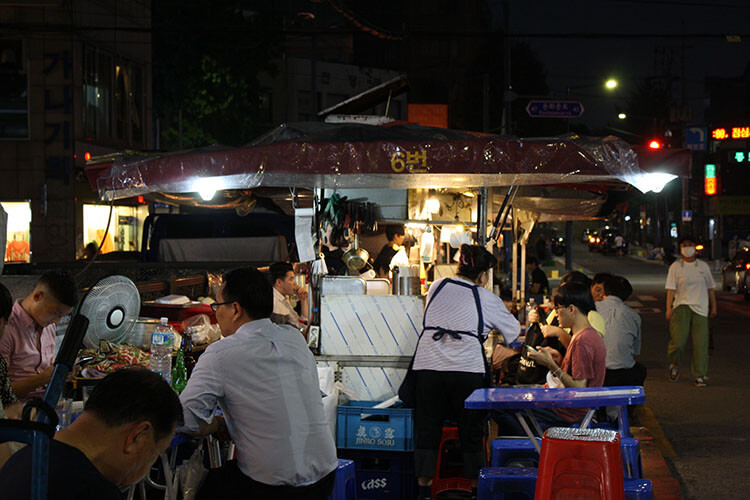
This piece should have ended there; juxtaposing the uniform acknowledgement of danger up to the point where you want to have a traditionally-Korean good time in a country growing ever safer. But on Liberation Day, August 15th, a far-right “church” hosted an anti-ruling party protest. The core of the city pulsated with the enraged chants of the 20,000-person crowd. Depressingly similar to the first wave of cases in the late winter, many members of the church refused to comply with government requests that members get tested. As a result, the number of positive cases rose as high as 441 per day in the subsequent weeks, and the Seoul government tightened regulations to prevent clusters from spreading. Such measures included shutting down all indoor sports facilities, closing restaurants at 9:00 PM, moving all schools and academies to online lessons, and reducing the number of late-night buses.
Lockdown-lite seemed to have worked, with the Seoul city government reducing the caution level from 2 to 1 in October. However, there is still a tension throughout the city as we try to get back to business as usual. At least, we remind ourselves here as we look at news from our adoptive countries, it can always be worse.












